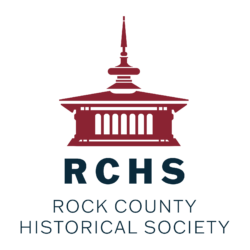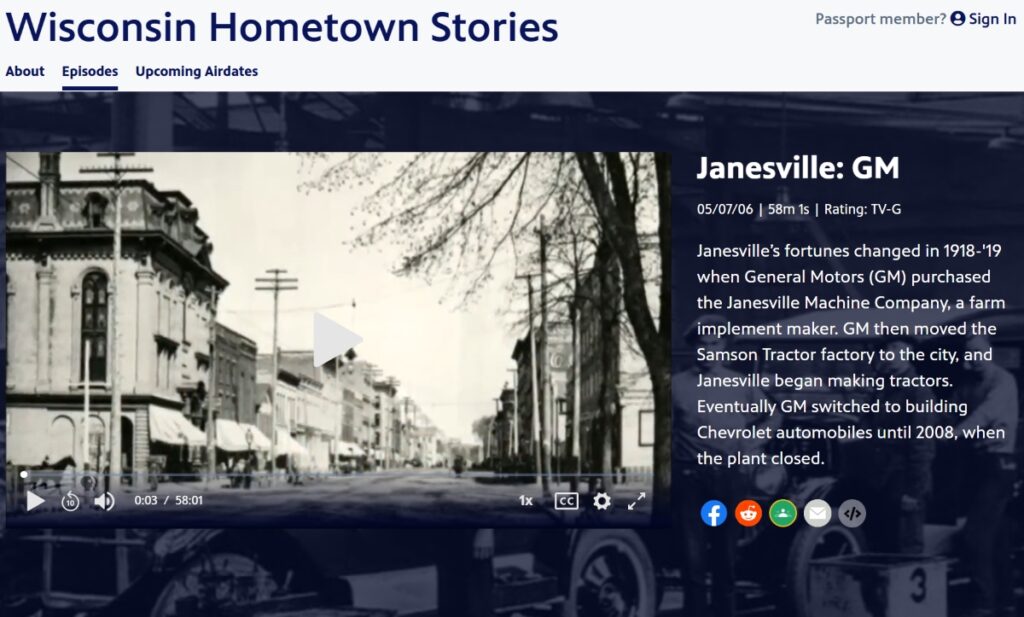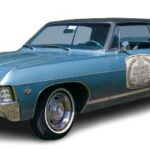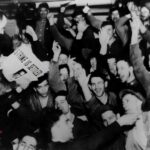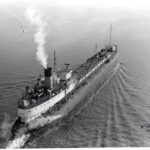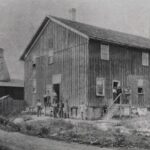The Janesville Assembly Plant’s near ninety-year run helped define both the city and its workers and the General Motors Company as one of the most successful automakers in the world. The history of the plant is deeply rooted in Janesville’s agricultural past. Begun in 1919 with the merger of the Janesville Machine Company, a manufacturer of farming implements, and Samson Tractor, a California-based company purchased by General Motors in 1917, the Janesville Assembly Plant transitioned from a farm machine manufacturer into an automobile assembly line in 1923. It was the ingenuity, skill, and industriousness of Janesville’s work force that both brought GM to the city and contributed to General Motors’ national success. At the same time, General Motors led the growth of the city and helped establish its national reputation. The ways that the workers, the plant, and the city of Janesville are intertwined demonstrate how the history of these relationships have given shape to the city today.
The early history of the Janesville Assembly Plant demonstrates the push-and-pull nature of the relationship of General Motors and Janesville. During World War I, General Motors decided to get into the tractor industry by buying up smaller companies, including Samson Tractors. Soon after acquiring Samson, GM began looking for a location to move the company from California to the Midwest. They attempted to entice Joseph A. Craig, general manager of the successful Janesville Machine Company, to leave Janesville to head the struggling Samson division, but Craig instead persuaded GM to move the Samson Tractors to Janesville to utilize the city’s already skilled labor force, a central location, and a pivotal rail network.

Following the 1919 merger of Janesville Machine and Samson Tractors, GM built a new plant in Janesville. Unfortunately, the tractor manufacturing boom crashed following the end of World War I, and the Samson Tractor Company Division of General Motors in Janesville shut down only three years after their first tractor rolled off the line. As GM began to make plans to leave Janesville, Joseph A. Craig was again able to convince the company to stay to produce other GM products, arguing that Janesville had been a great host city that had kept their promises to the company—including building public infrastructure to support the new plant and erecting a new high school to educate future workers. Because of Craig’s influence, GM expanded its influence in the city by building the Fisher Body Plant in 1923, and Fisher Body and Janesville Assembly began producing Chevrolet cars. The first Chevrolet car rolled off the line in Janesville that same year.

General Motors’ entrance into Janesville in the early 20th century drastically boosted the city’s population and recognition on the national scale. The city’s population of 14,000 at the time Samson Tractor began production in 1919, boomed to 20,000 in just eighteen months. At the company’s peak in the 1970s, the plant employed over 7,000 workers; about 1 out of every 7 people of the city’s population of 46,000, was employed by General Motors. The company’s presence in the city and success have played an immeasurable role in the prestige and national recognition of the city. For many years Janesville’s identity has been bound to and defined by the success of the assembly plant, exemplified by the company’s production of the 100 millionth General Motors vehicle in 1967. This vehicle celebrated both the accomplishments of General Motors and of GM workers throughout the country, especially those in Janesville.
Although General Motors brought many good things to the city of Janesville and its workers, their relationship was not one-sided. Janesville brought GM recognition on the world stage and hard work for decades. In 1933, 200 workers from the Janesville Assembly Plant represented the company in the GM Pavilion at the 1933 Chicago World’s Fair. In 1932, GM had decided to temporarily close the Janesville plant due to the Great Depression and Wisconsin’s increased corporate tax rate, but the company offered employment at the pavilion for plant employees looking for work. The fair, called The Century of Progress. was planned to celebrate Chicago’s centennial and promote American technology. The 200 workers from GM Janesville created quite a spectacle as they worked on an assembly line that was visible to onlookers, producing Chevrolet Master Eagle sedans that could be purchased right off the line by fair visitors. This exhibit was a massive success for General Motors and so it was continued again in 1934. The pavilion not only afforded publicity for General Motors and demonstrated to the public how interesting the car-building process was, but it also celebrated the skill of Janesville’s plant employees as the model workforce of the American automotive industry.
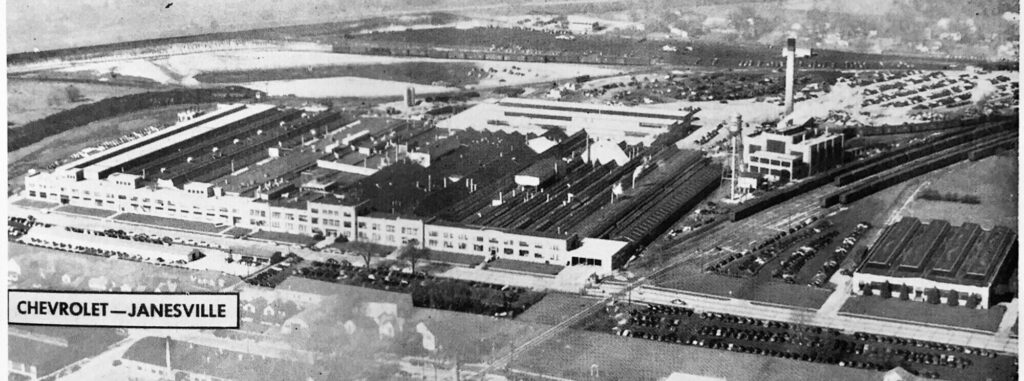
Janesville GM’s hardworking employees made the assembly one of the company’s most successful. A 1954 article of the Janesville Gazette reported that the plant had produced the fourth highest cumulative number of Chevrolet vehicles of any plant nationwide, despite the fact that Janesville Assembly had begun production over a decade after Chevrolet was founded. The article goes on to state that Janesville workers had been putting in more work to keep up with current demand, producing 167,000 cars per year on average between 1949 and 1954, compared to their previous peak output average of 100,000 per year. Their high level of production demonstrates Janesville workers’ hard work, as they ramped up production and were able to rise to the occasion.
However, this immense output did not come without proper treatment of the company’s workforce, and the employees of the Janesville Assembly Plant played a significant role in the establishment of the national automotive workers labor union, the United Auto Workers. In 1937, at the bequest of the fledgling UAW, employees in Janesville participated in a sit-down strike in solidarity with striking workers in Flint, Michigan. This demonstration not only succeeding in improving working conditions locally, but it established the power of the UAW on a national scale. Janesville workers joining with other striking workers at GM plants throughout the country forced GM to acknowledge and negotiate with the United Auto Workers (UAW), to reach a contract that benefitted workers at GM plants across America. From that point onward, the UAW worked tirelessly for automotive workers, bargaining with companies like General Motors. In Janesville specifically, the UAW fought to keep GM in Janesville as the company threatened to pull out of the city numerous times beginning in the 1980s. They also fought to grant pensions and retirement healthcare plans for GM employees. Even though Janesville Assembly ultimately closed in 2008, the UAW continues to fight for former employees, ensuring that GM continued to honor worker’s contracts and earned benefits.
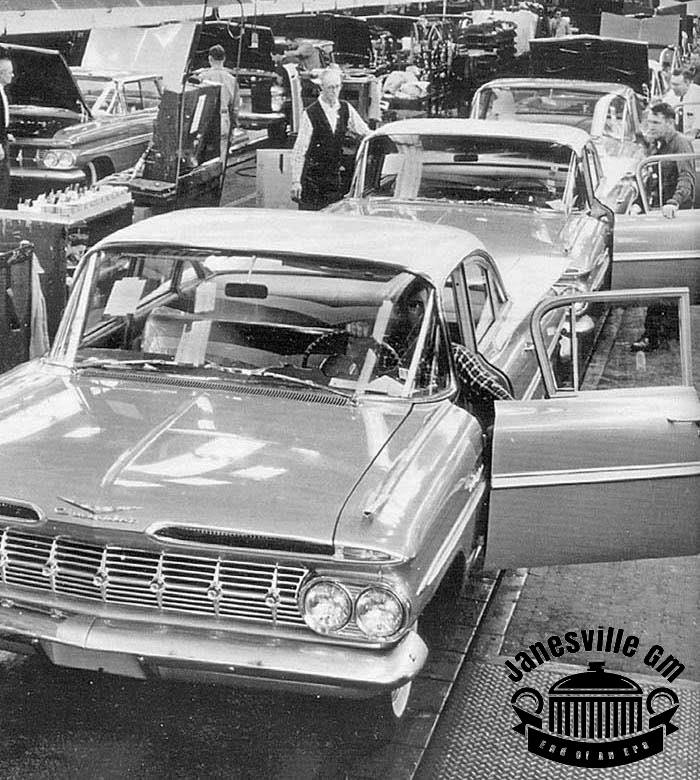
Despite the closure of the Janesville Assembly Plant, its legacy lives on to this day through the fabric of the city, its former employees, and the UAW. The accomplishments of Janesville’s GM employees can never be diminished, and are exemplified by artifacts like the 100 millionth GM car (now housed at the Rock County Historical Society) or the legacy of the 1933 Century of Progress Exposition. Further, the plant workers’ hard work, embodied in the 100 millionth vehicle and displayed at the World’s Fair, survives in the city through a new generation. Janesville industriousness still survives in other GM plants where former Janesville employees transferred, as the UAW fought to ensure GM would honor employment contracts. The determination of strikers in the 1930s still lives on as well, as the UAW continues to honor its pensions and to advocate for retired Janesville GM workers’ earned benefits. The story of General Motors cannot be told without including Janesville; likewise, Janesville’s story cannot be told without General Motors.
Written by Gabriel Corro, December 2024.
Sources
“City Celebrates GM’s Milestone.” Janesville Gazette. April 21, 1967.
“Craig’s tractor deal still has Janesville trucking.” McClatchy – Tribune Business News; June 3, 2008. https://www.proquest.com/docview/456489016
Mike Dupre, “GM has long, rich history in Janesville.” McClatchy – Tribune Business News; June 3, 2008. https://www.proquest.com/docview/464995523
Mike Dupre, Century of Stories: A 100-Year Reflection of Janesville and Surrounding Communities. Janesvillle, Wis: Janesville Gazette, 2000.
“General Motors Building & Exhibit,” Chicagology (website). Accessed August 2024. https://chicagology.com/centuryprogress/1933fair02/
“GM Milestone Observed Here.” Janesville Gazette. December 22, 1954.
“Residents Sad, Scared and Surprised.” Janesville Daily Gazette, December 22, 2008
Austin Weber, “GM Centennial: Show & Tell.” Assembly, December 13, 2013. https://www.assemblymag.com/articles/85839-gm-centennial-show-tell.
Rock County Historical Society
Research for this object and its related stories was supported by the Rock County Historical Society in Janesville, Wisconsin.
Learn more about the history of the Janesville Assembly Plant with PBS Wisconsin!
Janesville’s fortunes changed in 1918-’19 when General Motors (GM) purchased the Janesville Machine Company, a farm implement maker. GM then moved the Samson Tractor factory to the city, and Janesville began making tractors. Eventually GM switched to building Chevrolet automobiles until 2008, when the plant closed.
Watch the video on the PBS Wisconsin site.
